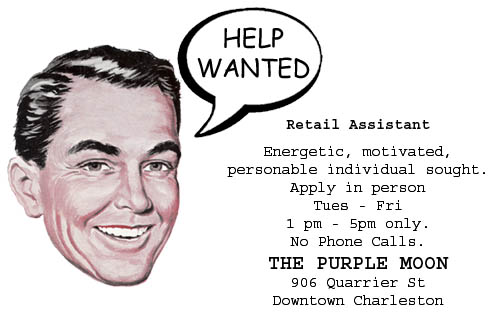
Gregory Corso & The Saturn Family
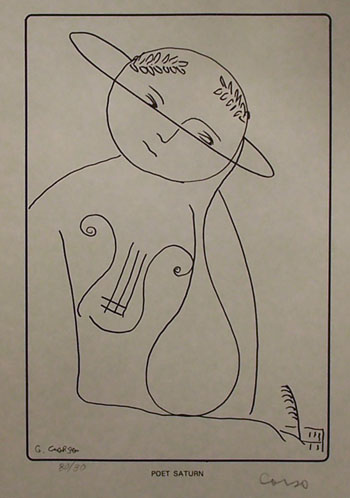
Poet Saturn – Gregory Corso – 1981
The Saturn Family series of prints was published in 1981 by The Parchment Gallery which was a venture of University of Charleston Professor William Plumley. The six piece set of signed prints were sold together as a portfolio and the edition was limited to 80. Correspondence between Corso and Plumley which I located while researching these pieces seem to indicate Corso had, at least initially, thought only one of the six was going to produced and even complained about having to sign so many.
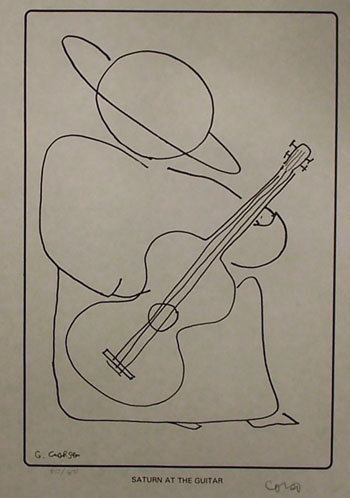
Saturn at the Guitar – Gregory Corso – 1981
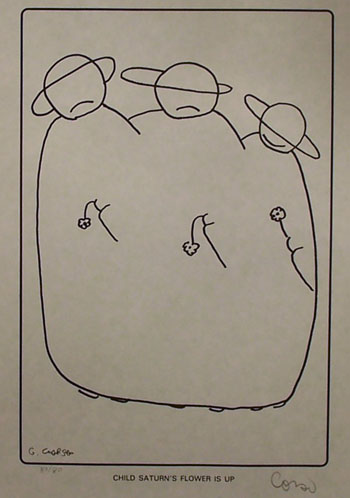
Child Saturn’s Flower is Up – Gregory Corso – 1981
According to the Academy of American Poets, Gregory Nunzio Corso was born in New York’s Greenwich Village on March 26, 1930, to teenage Italian parents. A year later, his mother moved back to Italy. After living in orphanages and foster homes, at age eleven Corso moved back in with his father, who had just remarried. After two years, however, he ran away; upon being caught he was placed in a boys’ home for two years. He was returned to his father, but after running away again was sent to Bellevue Hospital for three months “for observation.”
At age sixteen, he began a three-year sentence at Clinton State Prison for theft. While in prison, he read widely in the classics, including Dostoevsky, Stendahl, Shelley, Thomas Chatterton, and Christopher Marlowe, as well as the dictionary; it was there that he also began writing poems.
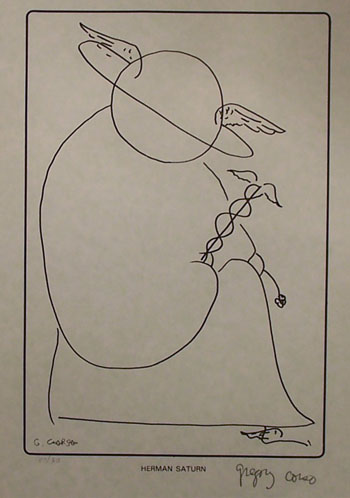
Herman Saturn – Gregory Corso – 1981
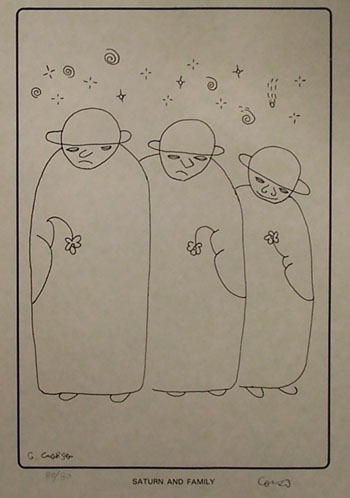
Saturn and Family – Gregory Corso – 1981
In a Greenwich Village bar in 1950, the year of his release from prison, he met Allen Ginsberg, who introduced him to experimental poetry. In 1954 he moved to Boston, where again he devoted himself to the library—this time at Harvard University. His first published poems appeared in the Harvard Advocate in 1954, and the publication of his first book, The Vestal Lady on Brattle and Other Poems (1955), was underwritten by Harvard and Radcliffe students. Corso worked at times as a laborer, a newspaper reporter for the Los Angeles Examiner, and a merchant seaman.
The following year he went to San Francisco, where he performed readings and interviews with Ginsberg and Jack Kerouac and became known as one of the major figures of the Beat movement. From 1957 to 1958 Corso lived in Paris, where he wrote many of the poems that became his book Gasoline, which Lawrence Ferlinghetti /City Lights Books published in 1958. From 1970 to 1974 Corso worked on a manuscript that was to be titled Who Am I—Who I Am, but the manuscript was stolen. He did not issue another major work until 1981’s Herald of the Autochthonic Spirit. Among other notable books are Bomb (1958), The Happy Birthday of Death (1960), Long Live Man (1962), Elegaic Feelings American (1970), and Mindfield: New and Selected Poems (1989).
Gregory Corso died on January 17, 2001, at the age of seventy.
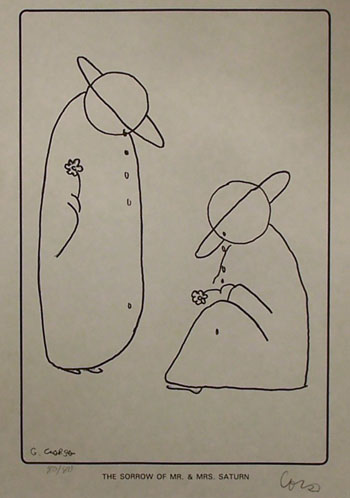
The Sorrow of Mr. & Mrs. Saturn – Gregory Corso – 1981
This rare set of prints is currently on exhibit in The Over the Moon Gallery of The Purple Moon.
Andy Warhol’s 80th Birthday
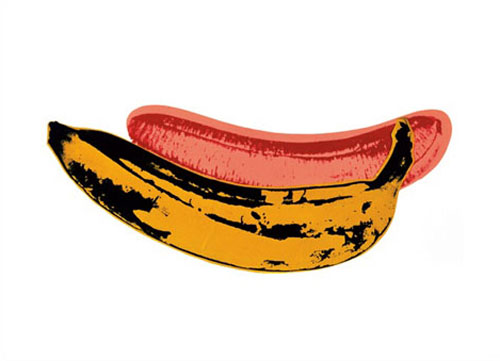
Banana – Andy Warhol – 1966
While reflecting on the work and life of Andy Warhol, who was born 80 years ago today, I got to thinking about Pop Art in general.
My first exposure to Pop Art was just before I turned 6 years old in 1964. My father was given a “gag gift” for his birthday of a plastic banana taped to piece of cardboard which had been framed. I remember he opened the gift and looked at it with a puzzled look on his face until the gift-giver told him it was a work of “pop art” and surely would be worth a fortune someday. The adults at the party all broke into laughter.
The “art” was promptly hung on the den wall where it stayed for a few years.
I loved that piece. I was as intrigued as a six year old could be as to what “pop art” was and what a banana on a piece of cardboard had to do with it. I even made a few of my own, browbeating my mother into buying me some plastic fruit at the old Bazaar Department Store in Huntington so could I make some similar works with plastic apples and even one with grapes.
While that being Pop Art (or even art) or not may be arguable. But what I was creating was certainly art to me at the time and I have never forgotten it.
It was a good number of years later before I ever heard of anyone named Andy Warhol. In fact, he painted his first banana in 1966. I am not sure my father and his friend had even heard of Warhol yet when the plastic banana art was created. I do remember being completely exstatic seeing my first Warhol banana. It immediately took me back to that old plastic banana taped to the cardboard from years before.
I guess it was Pop Art.
Anyway, that is where thinking about Andy Warhol’s birthday took me today. I wish Andy were still around – I’d send him a plastic banana.
The Purple Moon’s New Website is Now Up!
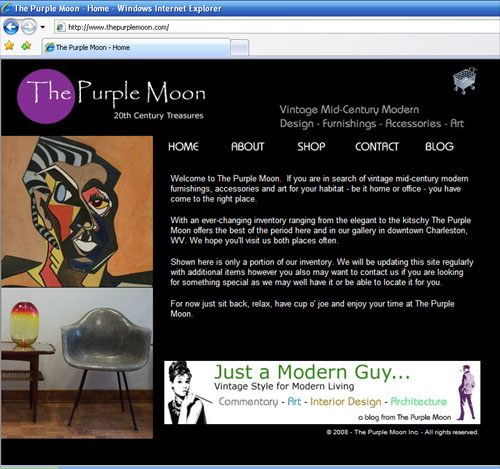
Screenshot of thepurplemoon.com’s brand-spanking new website
After a few months of planning, being interrupted by little things like moving the whole damn shop, hundreds of photographs and more than a little procrastination the new website for The Purple Moon is up and running as of today!
There are still some functions I hope to add and this still has only a portion of our inventory. All in all though it certainly is a better representation of our shop as it is now and I’m much happier with the design. The is more to come but the biggest part of the work is now behind me and the website is now live!
Stop by and take a peek.
Eva Zeisel’s Museum White by Castleton for MoMA – 1943
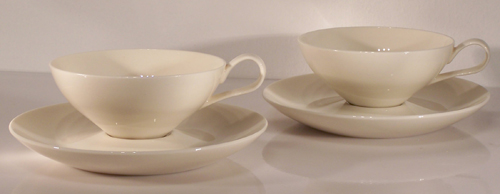
Museum White Cup & Saucer Pair – Castleton China for Museum of Modern Art – Designer: Eva Zeisel – 1943
Described by New York Magazine as “…delicate and voluptuous, tableware where the tactile verges on the erotic.”
Pretty heady words for dishes – but then these are more than mere dishes. Designed by the legendary Eva Zeisel for the Museum of Modern Art in 1943 and produced by Castleton China the Museum White line is art and function combined.
I was lucky enough to obtain a set of six cups and saucers recently and let me tell you they are a joy to look at and to use.
Zeisel, by the way, will celebrate her 102nd birthday on November 13th.
1940’s Blenko Glass – The “Pre-Designer” Period
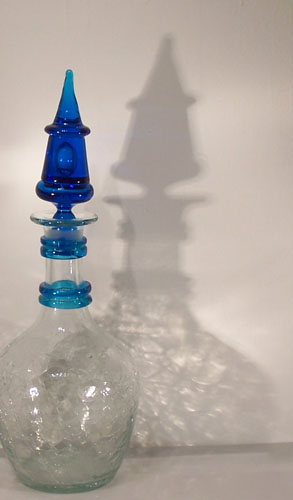
#475 Decanter – Blenko Glass – 1947
Before Winslow Anderson, Wayne Husted and Joel Myers were designing the glorious pieces during Blenko Glass’ “golden years” of the 1950’s and 60’s there was the time that has come to be known to some collectors as the “pre-designer” period. While really not true, as these pieces had to be designed by someone, it was prior to the hiring of a full-time industrial designer by the firm.
During this time most pieces were designed primarily by Richard Blenko Sr. along with his team of craftsmen. The sales department also played a role in developing items they believed would do well in the marketplace. Certainly the work coming out of the company prior to 1948 did not lack in style, imagination or beauty as can be seen in examples like the #475 decanter shown above.
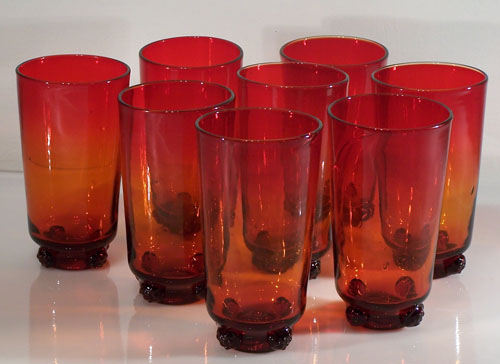
#445HB Tumbler Set – Blenko Glass – 1944
With the hiring of Winslow Anderson and the appearance of his first designs in the 1948 catalog Blenko Glass certainly saw a change in direction towards a more Scandanavian look. However it was more of an evolution than a revolution as the strength of Blenko design was there even before the first “designer” arrived. Luckily, that evolution continues through today.
Danish Teak Bookcase
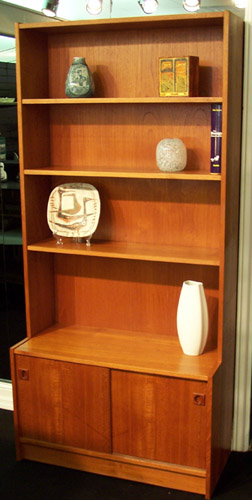
Teak Bookcase – Made in Denmark – circa 1964
The beautiful, glowing teak bookcase from Denmark was one of my early Saturday morning finds in the wilds of West Virginia this week. In nearly pristine condition this great piece looked even better after a good rub down with some teak oil.
I just never know what I’m going to run into while out on “the hunt” but finding gems like this certainly motivates me to go at it again next week!
Conant Ball ModernMates by Russel Wright
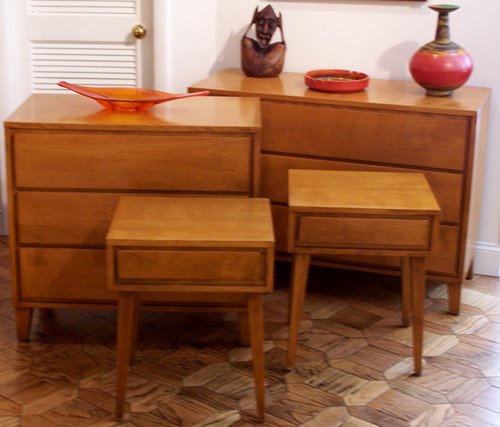
ModernMates Chests & Bedside Tables – Conant Ball – Designed by Russel Wright – 1949
I just found this week this wonderful set from Conant Ball’s ModernMates line designed by Russel Wright. With its modern component design in brushed birch this furniture was the follow-up to Wright’s American Modern for Conant Ball which began production in 1935.
As with so much of what we find the modern lady and I have the debate of if it goes to the showroom or home. This one is in the shop for now.
Sol Bloom Catch-It-All by Design for Moderns
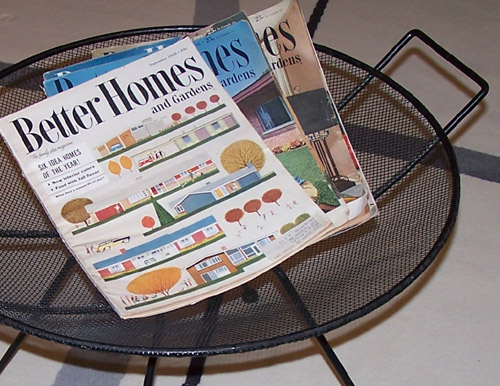
Catch-It-All Detail with Better Homes & Gardens – Designer: Sol Bloom
Useful, eye-catching, sleek, graceful and oh so modern the “Catch-It-All” designed by Sol Bloom and produced by Designs for Moderns in California for a very short period beginning in 1952 epitomizes mid-century modern design for the home. This seemingly simple object is sculptural in its design and extremely functional while retaining its minimalist qualities. A true masterpiece.
Not many of these classic pieces have survived the years and they were not made for long. Records are scarce but it appears as though by 1954 or so production ceased. Many were used outdoors and lost to the elements and still others discarded over the years by owners who did not recognize the rarity, value or design significance of these “magazine holders” as many called them.
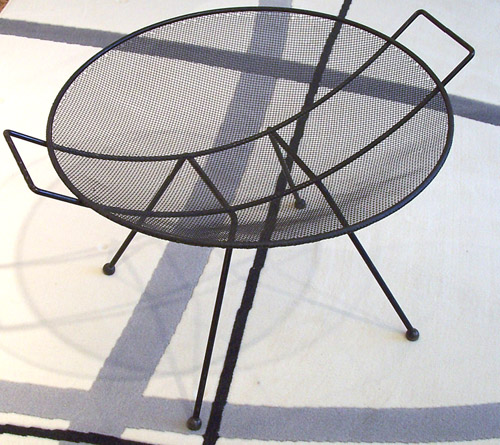
Catch-It-All – Design for Moderns – Circa 1952 – Designer: Sol Bloom
I was fortunate enough to come upon this one on trip through Pennsylvania and Virginia not too long ago. In excellent condition with no breaks to the fine metal mesh this 20th Century treasure is one of those finds which keep people like me hunting for more.
David Williamson Opening – Museum of American Glass – August 7th

The work of Canadian glass artist David Williamson will be on display at the West Virginia Museum of American Glass in Weston beginning August 7th and will open with an artist reception and Q&A from 7 to 9 p.m.
For those unfamiliar with the WVMAG it is one of West Virginia’s true treasures and just this year moved to a bigger and better home. The museum is located at 230 Main Avenue in Weston and is open 12 – 4 p.m. most days- however they are closed on Wednesday and Sunday.
The David Williamson exhibition, Threshold Awareness, will run through December 5th.
